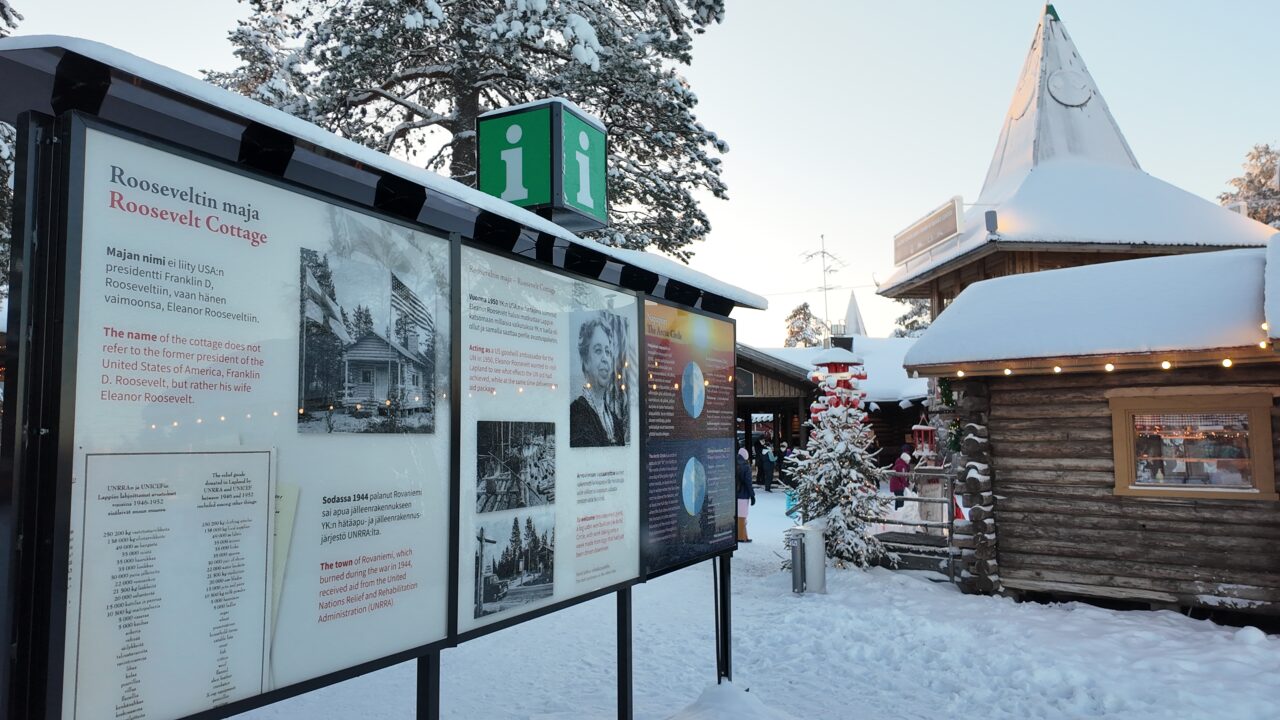
Info & tips
Roosevelt Cottage – The first building in the Arctic Circle
Roosevelt Cottage – The first building in the Arctic Circle
At the centre of the bustling Santa Claus Village is a tiny, unique cabin. Have you ever heard the incredible history of the cottage itself?
Rovaniemi, burned during war in 1944, gets aid for reconstruction from United Nations
The story begins in the aftermath of World War II. Rovaniemi suffered dearly during the war. In October 1944, Rovaniemi’s civil population was evacuated, but the city was burned almost to the ground by the retreating German army. Over 90% of the buildings were destroyed, and the city and its surrounding region were littered with landmines as the Germans fled.

The post-war reconstruction of Rovaniemi was a very slow and difficult task, as northern Finland lacked both construction materials and adequate nutrition for its population during the last half of the 1940s. Therefore, Rovaniemi and greater Lapland were among the first recipients in post-war Finland of aid provided by the United Nations Relief and Rehabilitation Administration (UNRRA), the predecessor to modern-day UNICEF.
UNRRA’s goodwill ambassador & soul Mrs. Roosevelt wishes to cross the Arctic Circle in Rovaniemi
First Lady Eleanor Roosevelt, widow of Franklin D. Roosevelt, president of the United States from 1933-1945, was widely known as the “soul” of the UNRRA. Mrs. Roosevelt, a world-renowned activist famous for her humanitarianism, decided to visit Rovaniemi in the summer of 1950, so she could monitor the progress of the post-war reconstruction first-hand. The First Lady also expressed her wish to cross the Arctic Circle while visiting the capital of Finnish Lapland.

The news of her pending visit to the Arctic Circle reached Rovaniemi only two weeks before her arrival.
Uuno Hannula, the governor of Lapland, rose to the challenges of fulfilling Roosevelt’s wish, which were not slight, as nothing but wilderness existed at the time where the national road crossed the geophysical line of the Arctic Circle. With only a couple weeks until her visit, the heads of Rovaniemi met at the legendary Hotel Pohjanhovi and agreed to construct a cabin at the Arctic Circle for Roosevelt’s welcoming ceremony.
Historical cottage constructed in less than two weeks
The mayor of Rovaniemi, Lauri Kaijalainen, helped Governor Hannula coordinate the construction by finding a suitable piece of land for a cabin bordering the northbound Highway 4. The land was donated by Eemeli Karinen. The land for the cabin was actually located just over 100 metres south of the exact geophysical location of the Arctic Circle, as the exact location of the line in 1950 was marshland and unsuitable for any kind of construction.

The Arctic Circle cabin had to be erected and finished in less than two weeks. With no time to waste, the cabin was designed overnight by local architect Ferdinand Salokangas, who then passed the baton to Jarl Sundquist’s experienced construction crew. The logs for the building were pulled straight out of the Ounasjoki river only eight days before the arrival of the honored guest. According to the instructions, the number of logs needed was “enough to build a house that can host a bus load of people.”
Under the leadership of master builder Yrjö Kamunen, skilled carpenters rushed to build the cabin, working long days and double-shifts. During the final days of construction, people worked around the clock, miraculously finalizing the cabin in only a week, its doors installed just in time for the landing of Roosevelt’s airplane in Rovaniemi.

Santa Claus Village grows up around the Roosevelt cottage
In addition to bringing hope for a better tomorrow to the people of Lapland living in post-war scarcity, Mrs. Roosevelt’s visit was also of paramount importance for local tourism. The Roosevelt cabin marked the first effort to attract a growing number of visitors to stop at the Arctic Circle, enjoy a cup of coffee, buy souvenirs and send a postcard home bearing the special Arctic Circle postmark.

Today, this unique cabin symbolizes not only the cooperation of America and Finland, but also the idea that when different nations support each other during challenging times, something beautiful and historic like Santa Claus Village can emerge, bringing together millions of tourists and media followers from around the world every year with its fairy-tale Christmas spirit.
The cabin, open only in the summer in its early days, collected thousands of names in its visitors’ books every year. The names collected in those visitors’ books include not only ordinary tourists but numerous other dignitaries including U.S. President Lyndon B. Johnson, Soviet Union Secretary General Leonid Brezhnev, Yugoslavian President Josip Broz Tito, Crown Prince of Sweden Carl Gustav, the Shah of Iran Mohammad Reza Pahlavi, Senegalese President Léopold Sédar Senghor, and Israeli Prime Minister Golda Meir.
